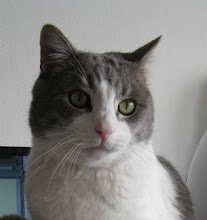Today the conference started for real. We kicked off with a plenary talk by Sean Carroll (of Endless Forms Most Wonderful fame), talking about evo-devo, and how what's important is the regulation of genes involved in development, not their actual protein product. I've read about some evo-devo, but now I feel I understand the point (I might blog more on this later).
After the plenary there were parllel session. Of course, there are always more than one that look interesting, so I started in the evolution in complex environments session. This kicked off with a nifty talk by Graham Bell, talking about adapation in bacteria. His starting argument was that the classic experiments of bacterial dynamics set up simple environments - one or two substrates, one or two clones etc. But this isn't the sort of environment the bacteria live in. He then talked about some experiments with many clones, in more complex environments (lots of substrate etc.).
Classically, we might expect to see trade-offs and specialisation in the use of different substrates, so that a clone that prefers glucose will be worse at using fructose, for example. But they didn't see this - instead everything just adapted equally. His conclusion was that the bacteria were "overlapping incomplete generalists": they could use a wide variety of resources reasonably well. The rest of the sesion was less interesting - playing with models and drawing pairwise invasability plots (beloved of adaptive dynamicists, obscure to everyone else).
After coffee (during wich I explained Genetics 101 to a senior professor), I went to the evolutionary epidemiology session. I missed the first half of the first talk because I didn't realise it was in another building (but did have a fascinating chat with a physchiatrist). The talk that was mostly interesting for me was Anna-Liisa Laine's. She's in Helsinki, she works on powdery mildew, but most of the times I see her, we discuss something else. So this was a good chance to find out what she's been doing.
Lunch was in a variety of restaurants - I was in Il Forno, where we didn't fornicate (perhaps they had better luck in Hörs).
After lunch, more epidemiology. The final talk was about where food poisoning comes from: using molecular tools to compare bacteria from food poisoning to samples from the environment and from animals (chickens, sheep, cows etc.). They threw some neat statistics at the problem, and could show that most of the poisoning came from meat, and not the environment. So, no need to wash your hands after playing with pigeon shit, then!
After this was the first poster session. This is hell if you're a student. You stand by a poster that you've sent two weeks on as people walk past thinking "can't be bothered - too much text on it". I don't have a poser (ha!), so I wondered round looking for the two or three interesting ones. I found a few - one using a really simple model for mating strategies - number of mates, variation in mating success etc. (a Dirichlet-multinomial. OK, simple if you're a statistician). There was also another poster that deserves its own entry....
That was the end of the official session - it was followed by the informal session, chatting to people, having lunch with the folks from Jyväskylä. For once I avoided the pub.
So, more today - looks like QTLs and conservation genetics.
Wednesday, 22 August 2007
ESEB: Tuesday
Posted by
Bob O'Hara
at
08:34
![]()
Labels: conference, ESEB
Subscribe to:
Post Comments (Atom)

No comments:
Post a Comment